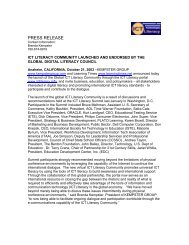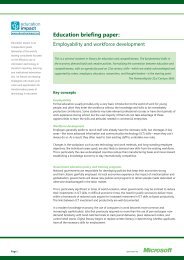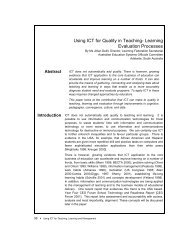147 pages pdf - ICT Digital Literacy
147 pages pdf - ICT Digital Literacy
147 pages pdf - ICT Digital Literacy
You also want an ePaper? Increase the reach of your titles
YUMPU automatically turns print PDFs into web optimized ePapers that Google loves.
Global & Cultural Perspectives -- How NOT To Get Lost In Translation<br />
#359: Hello, Hola, Alló<br />
Always offer students technical support, but also be sure the support speaks the language of the students.<br />
Eduardo Ramos<br />
Instituto Infnet<br />
#360: Turn The Audio On/Off As Per Your Bandwidth<br />
If yours is a large organization with many offices across the globe with varying bandwidths, go<br />
for two versions of a course: audio enabled and audio disabled. You can then deploy the<br />
audio-disabled version to those centers that have poor bandwidths.<br />
Linda Al Ansari<br />
Emirates<br />
#361: Going Globally Primer<br />
Before you decide to go global with your e-Learning offerings, consider cultural differences such<br />
as language, technology, local business practices, learning methodologies, and training needs.<br />
Evaluate the following data from your target markets: 1) market demand – user profile and<br />
course preference, 2) technology - internet access and cost, 3) language - web support for<br />
localized <strong>pages</strong>, and 4) culture - local learning practices.<br />
Karina Jensen<br />
Global Minds Network<br />
#362: Steady, But Surely<br />
In some cultures, it's necessary to build e-Learning acceptance slowly and with small successes.<br />
Laura Amick<br />
Wegmans Food Markets, Inc.<br />
#363: Group e-Learning Works Best For Some Cultures<br />
The 2 major challenges we are facing to deploy e-Learning in EMEA (Europe Middle East and<br />
Africa) are: 1) The motivation barrier: we can say whatever we want about an e-Learning event<br />
whether it be a WBT, a virtual classroom, a simulation, a remote lab exercise ... but many<br />
students feel isolated and lonely in front of their screens and 2) the language barrier:<br />
English/American is the common language for all of us but how good are we at using it for<br />
learning purposes? So, the idea I am currently piloting is to deploy local learning facilities for<br />
e-Learning events. What does it change? It's not purely virtual any longer because you will find<br />
classmates in the local learning facility participating in the same event ... or in another one. You<br />
are not lonely any longer because you can share with your colleagues in your native language<br />
the learning experience you are having. You can go with them for a coffee. This way, we rebuild<br />
in the local learning facility something we had in the classroom and attempt to rebuild something<br />
we have partially lost in most purely virtual events - the atmosphere of friendship that supports<br />
learning by engaging learners with the content, the instructor, and their peers. Motivation is an<br />
enabler or a catalyst for learning. My own experience has shown that in most cases, learners<br />
still need proximity their peers to be motivated and engaged.<br />
Olivier Lavergne<br />
Hewlett-Packard<br />
#364: Totally Lost In Translation<br />
If you are training internationally (which will happen more and more w/ remote solutions), you<br />
need to be very sensitive to your language, pronunciation and slang. "It isn't rocket science" or"<br />
Let's put together a straw man" doesn't mean anything to many people.<br />
Carmela Southers<br />
Ken Blanchard Companies<br />
701 e-Learning Tips by The MASIE Center www.masie.com 71

















